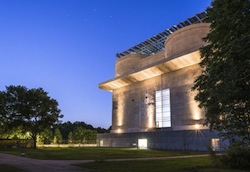A former air raid bunker has been transformed into an “Energy Bunker” in the district of Wilhelmsburg, located in Hamburg, Germany. The project was part of the 2013 International Building Exhibition Hamburg (IBA) that kicked off this week. The massive building had been derelict for several decades but is now the host of a regenerative power plant supplying the surrounding community with green energy.
 The project is part of the “Renewable Wilhelmsburg” climate protection scheme, which aims to provide the 50,000 Wilhelmsburg residents with CO2-neutral electricity by 2025 and with climate-neutral heating by 2050.
The project is part of the “Renewable Wilhelmsburg” climate protection scheme, which aims to provide the 50,000 Wilhelmsburg residents with CO2-neutral electricity by 2025 and with climate-neutral heating by 2050.
The surrounding neighborhood’s household energy is generated by a combination of energy sources: besides solar energy and biogas, the bunker also uses wood chips and waste heat from a nearby industrial plant, supplying heating energy to local households. What might be the project’s most innovative feature is its large-scale buffer storage facility with its 2 million litre capacity that integrates different eco-friendly heat and power units. The Energy Bunker also feeds the renewable power generated by its solar panels into Hamburg’s electricity grid, thereby supplying 3,000 households with heat and 1,000 households with electricity.
Another landmark project of the climate protection scheme is the “Energy Hill”, a former toxic landfill site that has been transformed into a renewable energy hill that, using solar energy and wind power, supplies 4,000 households with electricity.
Other pioneering projects include the “Energy Network Wilhelmsburg Central,” which integrates energy-generating facilities from various buildings into one large “virtual” power plant, and the BIQ House, which is setting new standards as the world’s first building to have a bioreactor façade. Microalgae are cultivated in the glass elements that make up the BIQ House’s “bio skin”. The house is part of the IBA “Building Exhibition within the Building Exhibition” project, which gives us a glimpse into urban life in the future.

